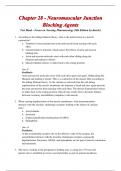Exam (elaborations)
Chapter 28 - Neuromuscular Junction Blocking Agents |Test Bank - Focus on Nursing Pharmacology (8th Edition by Karch)
- Course
- Institution
1. According to the sliding filament theory, what is the initial action in a muscle contraction? a. Troponin is freed and prevents actin and myosin from reacting with each other. b. Calcium binds to troponin, which causes the release of actin and myosin binding sites. c. Actin and myosin molecu...
[Show more]



